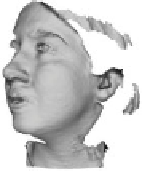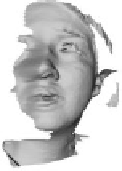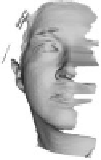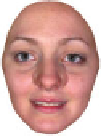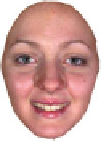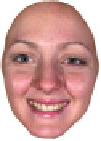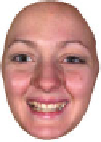Graphics Reference
In-Depth Information
frontal
left side
right side
Figure 5.2
GAVAB database: For a sample subject, the frontal scan and the two side scans are reported.
For the side scans, the given acquisition as provided in the database and its normalized counterpart are
shown so as to better evidence the extent of the missing parts of the face
The Binghamton University 3D Facial Expression (BU-3DFE) Database
The BU-3DFE database was recently constructed at
Binghamton University
(Yin et al., 2006).
It was designed to provide 3D facial scans of a population of different subjects, each showing a
set of prototypical emotional states at various levels of intensities. A total of 100 subjects exist
in the database, divided between female (56 subjects) and male (44 subjects). The subjects
are well distributed across different ethnic groups or racial ancestries, including
White
,
Black
,
East-Asian
,
Middle-East Asian
,
Latino-Americans
, and others. During the acquisition, each
subject was asked to perform the six basic facial expressions defined by Ekman, namely,
anger
(AN),
disgust
(DI),
fear
(FE),
happiness
(HA),
sadness
(SA), and
surprise
(SU), plus
the
neutral
(NE). Each facial expression has four levels of intensity—
low
,
middle
,
high
and
highest
—except the neutral facial expression. Thus, there are 25 3D facial expression scans
for each subject, resulting in 2500 3D facial expression scans in the database. As an example,
Figure 5.3 shows the 3D faces of sample subject for the
happiness
expression (four levels of
intensity) and the
neutral
expression.
Each of the 3D facial expression scan is also associated with a raw 3D face mesh, a cropped
3D face mesh, a set of 83
manually annotated
facial landmarks, and a facial pose vector.
These data give a complete 3D description of a face under a specific facial expression. The
cropped and textured 3D face scan, and the 83 facial landmarks are shown in Figure 5.4
a
.
happiness
neutral
high
highest
low
medium
Figure 5.3
BU-3DFE database: 3D textured face scans of a sample subject showing the
happiness
facial expression at the four levels of intensity (from
highest
to
low
) plus the
neutral
expression

